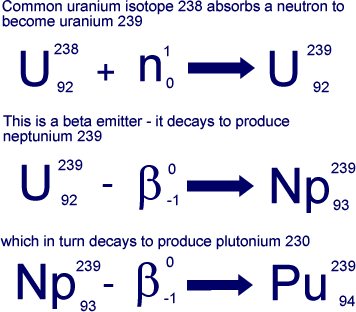    |
||||
 Nuclear
Power - Plutonium Nuclear
Power - Plutonium |
||||
|
Only 0.7% of natural uranium consists of the fissile isotope U235. Existing reactors use enriched uranium as fuel, in which the U235 fraction has been increased to 2-3½%. During operation of these reactors some of the non-fissile uranium is converted into plutonium.
A kilogram of plutonium-239 can release the explosive energy of 20,000 tons of TNT, making it the material of choice for fission weaponry. Plutonium was an important ingredient in the development and production of the first atomic bombs. Plutonium is a highly toxic radioactive silvery element of the actinoid series of metals.It is a transuranium element that has six known allotropic forms.The alpha-version is the one that exists at normal environmental temperatures. It is silvery colour that takes on a yellowish hue as it oxidises in the air.
An advanced type of reactor, the Fast Breeder, is fuelled by plutonium extracted from the spent fuel of existing reactors. As well as producing electricity, a fast breeder can also convert depleted uranium, which cannot be used in conventional reactors, into further plutonium. It can thus produce more plutonium than it consumes, providing additional fuel. In this way, a fast breeder can potentially extract about 60 times as much energy from each tonne of uranium as present reactors. If all the depleted uranium in storage in the UK were to be used in fast breeder reactors, it could potentially provide as much electricity as burning 20 billiontonnes of oil (about 7 times the UK's coal, oil and gas reserves). A prototype fast breeder at Dounreay in Scotland was closed in 1994, but experimental fast breeders continue operating in France, Japan and Russia. However,fastbreeder reactors are unlikely to be economic for several decades. Another long term energy source - which is the subject of research in the USA, Europe and Russia - is fusion power. In this process, heavy hydrogen nuclei are fused together to produce helium nuclei, with the release of large amounts of energy. This is the main source of the sun's energy output. Commercial fusion reactors are unlikely to be available until the latter half of this century.
|
||||
 |
||||



